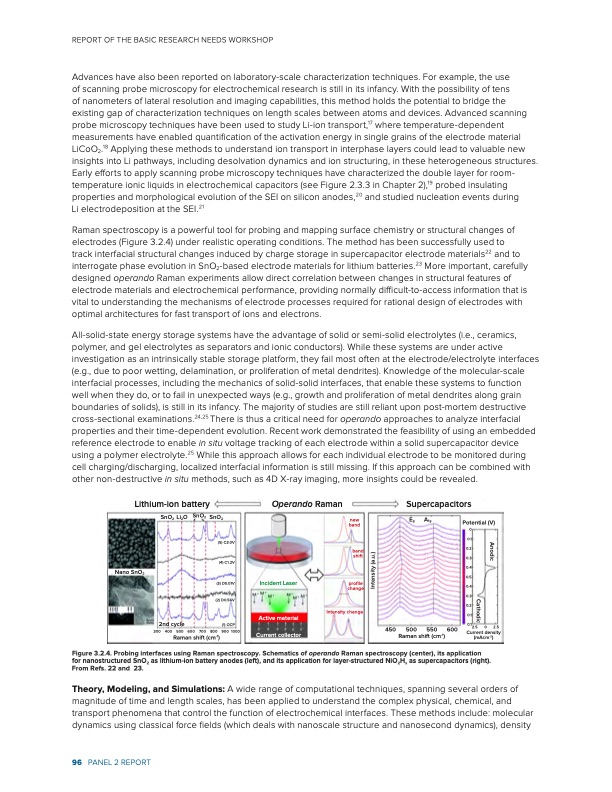
PDF Publication Title:
Text from PDF Page: 102
REPORT OF THE BASIC RESEARCH NEEDS WORKSHOP Advances have also been reported on laboratory-scale characterization techniques. For example, the use of scanning probe microscopy for electrochemical research is still in its infancy. With the possibility of tens of nanometers of lateral resolution and imaging capabilities, this method holds the potential to bridge the existing gap of characterization techniques on length scales between atoms and devices. Advanced scanning probe microscopy techniques have been used to study Li-ion transport,17 where temperature-dependent measurements have enabled quantification of the activation energy in single grains of the electrode material LiCoO2.18 Applying these methods to understand ion transport in interphase layers could lead to valuable new insights into Li pathways, including desolvation dynamics and ion structuring, in these heterogeneous structures. Early efforts to apply scanning probe microscopy techniques have characterized the double layer for room- temperature ionic liquids in electrochemical capacitors (see Figure 2.3.3 in Chapter 2),19 probed insulating properties and morphological evolution of the SEI on silicon anodes,20 and studied nucleation events during Li electrodeposition at the SEI.21 Raman spectroscopy is a powerful tool for probing and mapping surface chemistry or structural changes of electrodes (Figure 3.2.4) under realistic operating conditions. The method has been successfully used to track interfacial structural changes induced by charge storage in supercapacitor electrode materials22 and to interrogate phase evolution in SnO2-based electrode materials for lithium batteries.23 More important, carefully designed operando Raman experiments allow direct correlation between changes in structural features of electrode materials and electrochemical performance, providing normally difficult-to-access information that is vital to understanding the mechanisms of electrode processes required for rational design of electrodes with optimal architectures for fast transport of ions and electrons. All-solid-state energy storage systems have the advantage of solid or semi-solid electrolytes (i.e., ceramics, polymer, and gel electrolytes as separators and ionic conductors). While these systems are under active investigation as an intrinsically stable storage platform, they fail most often at the electrode/electrolyte interfaces (e.g., due to poor wetting, delamination, or proliferation of metal dendrites). Knowledge of the molecular-scale interfacial processes, including the mechanics of solid-solid interfaces, that enable these systems to function well when they do, or to fail in unexpected ways (e.g., growth and proliferation of metal dendrites along grain boundaries of solids), is still in its infancy. The majority of studies are still reliant upon post-mortem destructive cross-sectional examinations.24,25 There is thus a critical need for operando approaches to analyze interfacial properties and their time-dependent evolution. Recent work demonstrated the feasibility of using an embedded reference electrode to enable in situ voltage tracking of each electrode within a solid supercapacitor device using a polymer electrolyte.25 While this approach allows for each individual electrode to be monitored during cell charging/discharging, localized interfacial information is still missing. If this approach can be combined with other non-destructive in situ methods, such as 4D X-ray imaging, more insights could be revealed. Nano SnO2 (5) C3.0V (4) C1.2V (3) D0.01V (2) D0.56V (1) OCP 900 1000 new band band shift profile change Intensity change Eg A1g 500 550 Raman shift (cm-1) Potential (V) 0 0.1 0.2 0.3 0.4 0.5 0.4 0.3 0.2 0.1 0.12.5 0 2.5 Current density (mAcm-2) Lithium-ion battery SnO2 Li2O SnO2 SnO2 Operando Raman Supercapacitors 2nd cycle 300 400 500 600 700 Incident Laser Active material Current collector 450 600 800 Raman shift (cm-1) Figure 3.2.4. Probing interfaces using Raman spectroscopy. Schematics of operando Raman spectroscopy (center), its application for nanostructured SnO2 as lithium-ion battery anodes (left), and its application for layer-structured NiO2Hx as supercapacitors (right). From Refs. 22 and 23. Theory, Modeling, and Simulations: A wide range of computational techniques, spanning several orders of magnitude of time and length scales, has been applied to understand the complex physical, chemical, and transport phenomena that control the function of electrochemical interfaces. These methods include: molecular dynamics using classical force fields (which deals with nanoscale structure and nanosecond dynamics), density 96 PANEL 2 REPORT Anodic Cathodic Intensity (a.u.)PDF Image | Next Generation Electrical Energy Storage

PDF Search Title:
Next Generation Electrical Energy StorageOriginal File Name Searched:
BRN-NGEES_rpt-low-res.pdfDIY PDF Search: Google It | Yahoo | Bing
Sulfur Deposition on Carbon Nanofibers using Supercritical CO2 Sulfur Deposition on Carbon Nanofibers using Supercritical CO2. Gamma sulfur also known as mother of pearl sulfur and nacreous sulfur... More Info
CO2 Organic Rankine Cycle Experimenter Platform The supercritical CO2 phase change system is both a heat pump and organic rankine cycle which can be used for those purposes and as a supercritical extractor for advanced subcritical and supercritical extraction technology. Uses include producing nanoparticles, precious metal CO2 extraction, lithium battery recycling, and other applications... More Info
| CONTACT TEL: 608-238-6001 Email: greg@infinityturbine.com | RSS | AMP |